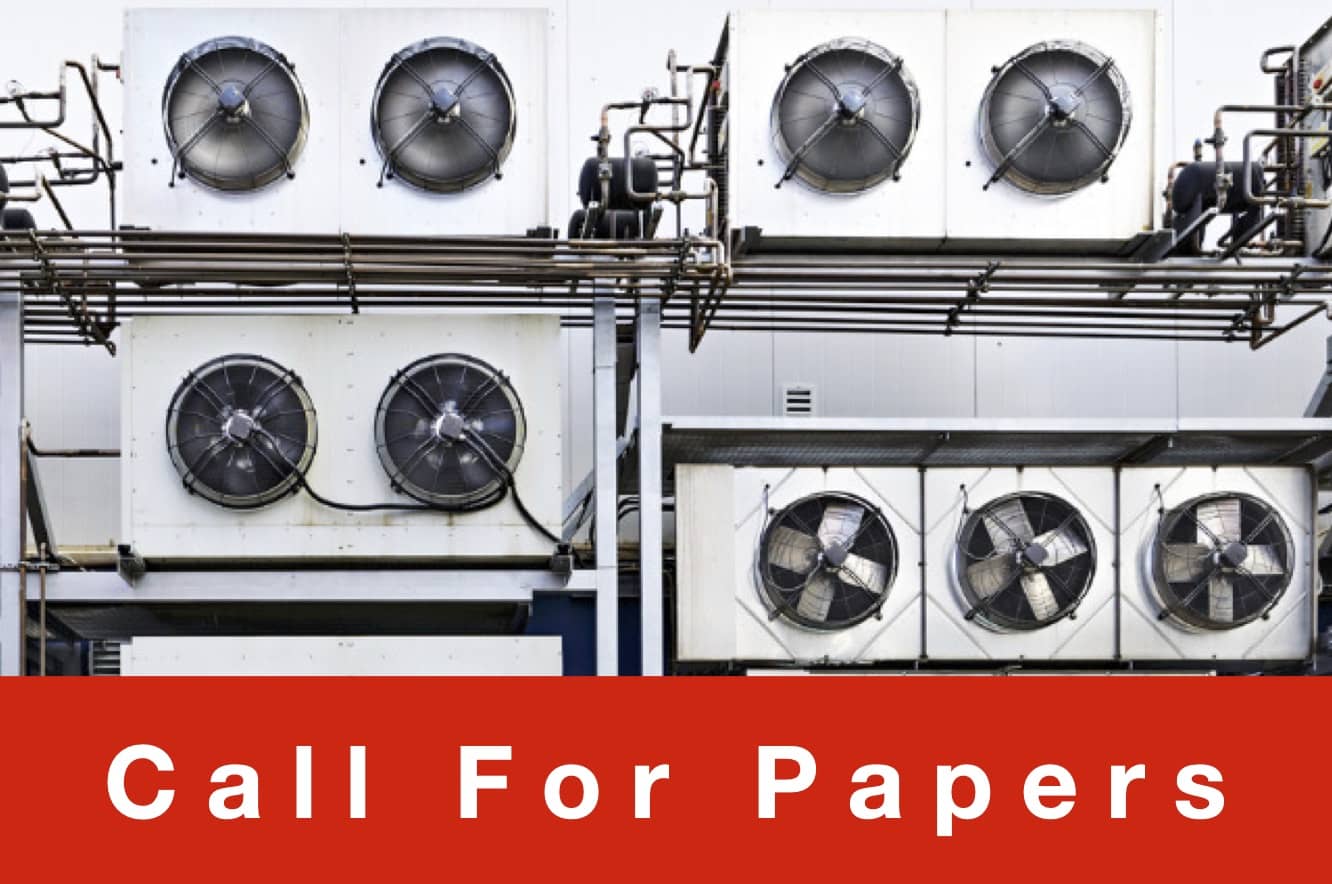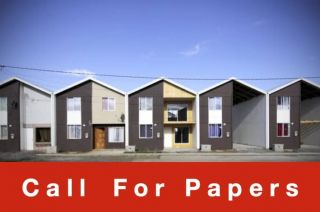
www.buildingsandcities.org/calls-for-papers/alternatives-air-conditioning.html
Alternatives to Air Conditioning: Policies, Design, Technologies, Behaviours

Guest Editors: Brian Ford (Nottingham U), Dejan Mumovic (UCL), Rajan Rawal (CEPT University)
Abstract submissions closed on 12 APRIL 2021
Can our cities and buildings be designed to have little or no mechanical intervention?
The alternatives to conventional air conditioning embrace much more than a technological issue - they require holistic design thinking and include social aspects (expectations, behaviours, practices) which may challenge the ways in which work, leisure and other activities are pursued. This special issue explores alternative approaches to providing thermal comfort and ventilation in different climatic zones across the world at the scales of building, neighbourhood and city. It considers the implications of these alternatives across a range of issues: health, wellbeing, air quality and heat stress; technical / design solutions; social expectations and practices; climate change; policy and regulation; supply chain and procurement; education and training. It includes a range of disciplines: geography, sociology, anthropology, behavioural sciences, architecture, engineering, public health, economics, energy and environmental assessment.
In urbanised areas, there is an opportunity to break the current dependency on air conditioning. The design of cities, neighbourhoods and buildings can ensure ventilation and thermal comfort by climate friendly means. Retrofit opportunities for the existing building stock can make existing buildings comfortable without increasing energy demand. The design of new buildings and their environs can reduce or eliminate the need for air conditioning.
Equally important are the responses of the many different actors that promote or inhibit adoption - policy makers, clients, construction professions and the supply chain (development and procurement). Key questions include:
- What constitutes a national cooling action plan?
- How resilient should buildings and cities be to a warmer world?
- How resilient to heat should buildings be if energy supply is disrupted?
- What role do design and construcion professionals and the supply chain have in implementing change?
Last year China and India introduced national cooling action plans, and France committed to the 'Biarritz Pledge' for fast action on efficient cooling. In 2019 the Global Cool Cities Alliance also issued their 'Million cool roofs challenge'. City scale action plans are vital. Ahmedabad published its first heat action plan in 2013 and there is now evidence that it is beginning to save lives among those who are most vulnerable. The Kigali Cooling Efficiency Program (K-CEP) is another example of energy-efficient, climate-friendly, and affordable cooling solutions to refrigeration and cooling.
Background: why are alternatives needed?
- Health and wellbeing. (not only Covid-19 and potential future pandemics) Re-circulation of untreared air may no longer be acceptable. The linkages between ventilation (100% fresh air) and health are increasingly identified as important. The pattern of air movement may be significant.
- Physiological need for thermal variation and ventilation.
- Adaptive measures to maintain thermal comfort.
- Energy demand and negative environmental impacts of refrigerants, waste heat, materials, etc (projected energy demand from a/c is not sustainable - new peak demands)
- Economics and equity (poorest people are made vulnerable)
- Changing social expectations and rapid urbanisation (increased demand)
- A changing climate (hotter - humid and/or more extreme)
Possible topics
Urban design issues - planning (building height, configuration, materials, external shading, over-shadowing, urban heat island, vegetation and open spaces, etc), effects on ventilation and cooling
Neighbourhood design - particularly microclimates (scale, shading, air movement, open space, trees and vegetation, urban 'oases').
Building design - spatial configurations of buildings to help achieve comfort, the performance and outcomes of new build and retrofit across a range of building types and technologies (see below), their design integration aspects, their impact on building morphologies, occupant agency (see below) and feedback. Reduction of loads e.g. shading, buffer zones, orientation, optimal window opening sizes, etc), advanced natural ventilation, wind tower systems, etc. Building materials and techniques.
Social behaviours & Inhabitant agency - how people actually inhabit buildings and cities. Patterns of occupation and practices inside and outside buildings include seasonal and diurnal adaptation which impact the need for cooling (e.g. the traditional siesta), communication of appropriate information on how to operate the building.
Cooling technologies and their application - examination different technologies (performance, economics, whole life impacts, etc) and their integration: natural ventilation, evaporative cooling, radiant cooling, night time cooling , ice cooling, ground water cooling, thermal mass and cooling, negawatt cooling.
Demographics - analysis increasing demand for air conditioning due to affluence, disparities within countries of a/c unit ownership, people adversely affected / made vulnerable now or in future climate scenarios.
Economics - macro analysis of different thermal comfort scenarios (capital and operating costs vs societal costs e.g. health, environmental, social impacts).
Policy, regulation & standards - what shifts & incentives are needed at individual building, neighbourhood and city scales to encourage buildings without mechanical systems, to create appropriate internal temperature targets, to protect the "commons" (e.g. eliminate waste heat from a/c), to provide planning for appropriate shading, ventilation, green infrastructure at neighbourhood & city scales.
Public health - comparison of mechanical vs non-mechanical ventilation: airborne infectious transmission rates, air movement patterns in rooms and buildings, CO2 concentration & air pollutants, the physiology of adaptive comfort, the influence of neighbourhood microclimate and the incidence/transmission of infectious disease
Energy use and environment impacts - impacts of a/c on energy demand, peak energy and GHG emissions.
Public attitudes - the anthropology of cooling, the current and changing expectations for cooling: thermal pleasure, cooling desire, air conditioning and 'development', public attitudes to cooling in warm places
Market transformation - analysis of current and alternative development & procurement models. Standard models reward developers for creating a/c buildings. What new models are needed for rewarding low energy alternatives, e.g cooling as a service (CAAS)? The business case for alternative approaches.
Education & training - What are the roles of individual teachers / staff in leading change? What resistance and difficulties do they meet? How can educators overcome these barriers?
Certification - are different / alternative processes of certification required for alternative cooling systems? Do professionals and vocational workers need different / additional / alternative qualifications to show they have appropriate skills?
Briefing Note for Contributors
You are invited to submit an abstract for a journal paper in this special issue of Buildings & Cities. In the first instance, please send a 500 word (maximum) abstract defining the scope, methods and results to Richard Lorch richard@rlorch.net by MONDAY 12 APRIL 2021. The initial abstract submission must include:
- the author's and all co-author's names, affiliations and contact details
- the question(s) and topics in this Call for Papers that the abstract and intended paper addresses
- the abstract (300 - 500 words maximum) which should include a description of methods and key findings
Abstracts will be reviewed by the editors to ensure a varied, yet integrated selection of papers around the topic of the special issue. Authors of accepted abstracts will be invited to submit a full paper which then undergoes a double-blind peer review process.
The journal publishes the several different types of papers: research, synthesis, policy analysis, methods, & replication. Details on their scope and length: https://www.buildingsandcities.org/about/aims-and-scope.html
Timeline
Deadline for abstract submission: 12 April 2021
Full papers due: 01 September 2021
Referees' comments: 01 December 2021
Final version due: 01 February 2022
Publication: April 2022
Note: papers are published as soon as they are accepted and therefore some papers will progress faster and appear in advance of the whole issue.
Buildings & Cities
Buildings & Cities is an international, open access, not-for-profit, double-blind peer-reviewed research journal. Its focus is the interactions between buildings, neighbourhoods and cities by understanding their supporting social, economic and environmental systems. More information including its Aims & Scope, Key Principles and Editorial Board can be found online: www.buildingsandcities.org. Buildings & Cities is an open access journal and has an article processing charge of £1200 (for research, synthesis and methods papers) and £1100 (for policy analysis and replication papers). If you do not have institutional support, please contact the editor-in-chief to discuss. We endeavour to assist those without funding to publish in our journal.
Questions?
If you have a question, please contact: Richard Lorch richard@rlorch.net (editor in chief), Brian Ford brian@naturalcooling.co.uk, Dejan Mumovic d.mumovic@ucl.ac.uk, Rajan Rawal rajanrawal@cept.ac.in
Further reading
Aram, F., Higueras García, E., Solgi, E. & Mansournia, S. (2019). Urban green space cooling effect in cities. Heliyon 5.
Brager, G., Zhang, H. & Arens, E. (2015) Evolving opportunities for providing thermal comfort. Building Research & Information, 43(3) 274-287.
Cole, R. J., Robinson, J., Brown, Z., & O'Shea, M. (2008). Re-contextualizing the notion of comfort. Building Research & Information, 36(4), 323-336.
Davis, L. W. & Gertler, P. J. (2015). Contribution of air conditioning adoption to future energy use under global warming. Proc. Natl Acad. Sci. USA 112, 5962-5967. https://www.pnas.org/content/112/19/5962
Ford, B., Schiano-Phan, R. & Vallejo, J.A. (2020) The Architecture of Natural Cooling (2nd edition). Abingdon: Routledge.
IEA. (2018). The future of cooling: opportunities for energy efficient air conditioning. Paris: International Energy Agency.
IEA. (2020). Progress Report on Cooling. Paris: International Energy Agency. https://www.iea.org/reports/cooling
Infante Ferreira, C. & Kim, D.S. (2014). Techno-economic review of solar cooling technologies based on location-specific data. International Journal of Refrigeration, 39, 23-37.
Khosla, R., Miranda, N.D., Trotter, P.A. et al. (2020). Cooling for sustainable development. Nature Sustainability https://doi.org/10.1038/s41893-020-00627-w
Kigali Cooling Efficiency Program - K-CEP(2018). Cooling as a Service (CaaS) https://www.k-cep.org/wp-content/uploads/2018/07/Cooling-as-a-service-Knowledge-brief-6.7.2018_Final_online_v1.pdf
Passe, U. & Battaglia, F. (2015). Designing Spaces for Natural Ventilation: An Architect's Guide. New York: Routledge.
Samuel, D.G.L., Nagendra, S.M.S. & Maiya (2013). Passive alternatives to mechanical air conditioning of building: a review. Building and Environment, 66, 54-64.
Short, C.A. (2017). The Recovery of Natural Environments in Architecture: Air, Comfort and Climate. Abingdon: Routledge.
Shove, E. (2018). What is wrong with energy efficiency? Building Research & Information, 46(7), 779-789.
Ürge-Vorsatz, D., Cabeza, L. F., Serrano, S., Barreneche, C. & Petrichenko, K. (2015). Heating and cooling energy trends and drivers in buildings. Renewable Sustainable Energy Review, 41, 85-98. https://www.sciencedirect.com/science/article/pii/S1364032114007151
Watts, N. et al. (2020). The 2020 report of The Lancet Countdown on health and climate change: responding to converging crises. Lancet. 396. DOI:>https://doi.org/10.1016/S0140-6736(20)32290-X
Latest Peer-Reviewed Journal Content
Acceptability of sufficiency consumption policies by Finnish households
E Nuorivaara & S Ahvenharju
Key factors for revitalising heritage buildings through adaptive reuse
É Savoie, J P Sapinski & A-M Laroche
Cooler streets for a cycleable city: assessing policy alignment
C Tang & J Bush
Understanding the embodied carbon credentials of modern methods of construction
R O'Hegarty, A McCarthy, J O'Hagan, T Thanapornpakornsin, S Raffoul & O Kinnane
The changing typology of urban apartment buildings in Aurinkolahti
S Meriläinen & A Tervo
Embodied climate impacts in urban development: a neighbourhood case study
S Sjökvist, N Francart, M Balouktsi & H Birgisdottir
Environmental effects of urban wind energy harvesting: a review
I Tsionas, M laguno-Munitxa & A Stephan
Office environment and employee differences by company health management certification
S Arata, M Sugiuchi, T Ikaga, Y Shiraishi, T Hayashi, S Ando & S Kawakubo
Spatiotemporal evaluation of embodied carbon in urban residential development
I Talvitie, A Amiri & S Junnila
Energy sufficiency in buildings and cities: current research, future directions [editorial]
M Sahakian, T Fawcett & S Darby
Sufficiency, consumption patterns and limits: a survey of French households
J Bouillet & C Grandclément
Health inequalities and indoor environments: research challenges and priorities [editorial]
M Ucci & A Mavrogianni
Operationalising energy sufficiency for low-carbon built environments in urbanising India
A B Lall & G Sethi
Promoting practices of sufficiency: reprogramming resource-intensive material arrangements
T H Christensen, L K Aagaard, A K Juvik, C Samson & K Gram-Hanssen
Culture change in the UK construction industry: an anthropological perspective
I Tellam
Are people willing to share living space? Household preferences in Finland
E Ruokamo, E Kylkilahti, M Lettenmeier & A Toppinen
Towards urban LCA: examining densification alternatives for a residential neighbourhood
M Moisio, E Salmio, T Kaasalainen, S Huuhka, A Räsänen, J Lahdensivu, M Leppänen & P Kuula
A population-level framework to estimate unequal exposure to indoor heat and air pollution
R Cole, C H Simpson, L Ferguson, P Symonds, J Taylor, C Heaviside, P Murage, H L Macintyre, S Hajat, A Mavrogianni & M Davies
Finnish glazed balconies: residents' experience, wellbeing and use
L Jegard, R Castaño-Rosa, S Kilpeläinen & S Pelsmakers
Modelling Nigerian residential dwellings: bottom-up approach and scenario analysis
C C Nwagwu, S Akin & E G Hertwich
Mapping municipal land policies: applications of flexible zoning for densification
V Götze, J-D Gerber & M Jehling
Energy sufficiency and recognition justice: a study of household consumption
A Guilbert
Linking housing, socio-demographic, environmental and mental health data at scale
P Symonds, C H Simpson, G Petrou, L Ferguson, A Mavrogianni & M Davies
Measuring health inequities due to housing characteristics
K Govertsen & M Kane
Provide or prevent? Exploring sufficiency imaginaries within Danish systems of provision
L K Aagaard & T H Christensen
Imagining sufficiency through collective changes as satisfiers
O Moynat & M Sahakian
US urban land-use reform: a strategy for energy sufficiency
Z M Subin, J Lombardi, R Muralidharan, J Korn, J Malik, T Pullen, M Wei & T Hong
Mapping supply chains for energy retrofit
F Wade & Y Han
Operationalising building-related energy sufficiency measures in SMEs
I Fouiteh, J D Cabrera Santelices, A Susini & M K Patel
Promoting neighbourhood sharing: infrastructures of convenience and community
A Huber, H Heinrichs & M Jaeger-Erben
New insights into thermal comfort sufficiency in dwellings
G van Moeseke, D de Grave, A Anciaux, J Sobczak & G Wallenborn
'Rightsize': a housing design game for spatial and energy sufficiency
P Graham, P Nourian, E Warwick & M Gath-Morad
Implementing housing policies for a sufficient lifestyle
M Bagheri, L Roth, L Siebke, C Rohde & H-J Linke
The jobs of climate adaptation
T Denham, L Rickards & O Ajulo
Structural barriers to sufficiency: the contribution of research on elites
M Koch, K Emilsson, J Lee & H Johansson
Disrupting the imaginaries of urban action to deliver just adaptation [editorial]
V Castán-Broto, M Olazabal & G Ziervogel
Nature for resilience reconfigured: global- to-local translation of frames in Africa
K Rochell, H Bulkeley & H Runhaar
How hegemonic discourses of sustainability influence urban climate action
V Castán Broto, L Westman & P Huang
Fabric first: is it still the right approach?
N Eyre, T Fawcett, M Topouzi, G Killip, T Oreszczyn, K Jenkinson & J Rosenow
Social value of the built environment [editorial]
F Samuel & K Watson
Understanding demolition [editorial]
S Huuhka
Data politics in the built environment [editorial]
A Karvonen & T Hargreaves



Latest Commentaries
Decolonising Cities: The Role of Street Naming
During colonialisation, street names were drawn from historical and societal contexts of the colonisers. Street nomenclature deployed by colonial administrators has a role in legitimising historical narratives and decentring local languages, cultures and heritage. Buyana Kareem examines street renaming as an important element of decolonisation.
Integrating Nature into Cities
Increasing vegetation and green and blue spaces in cities can support both climate change mitigation and adaptation goals, while also enhancing biodiversity and ecological health. Maibritt Pedersen Zari (Auckland University of Technology) explains why nature-based solutions (NbS) must be a vital part of urban planning and design.